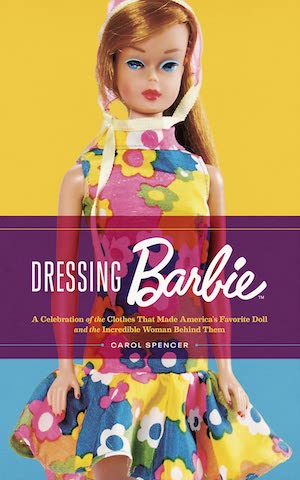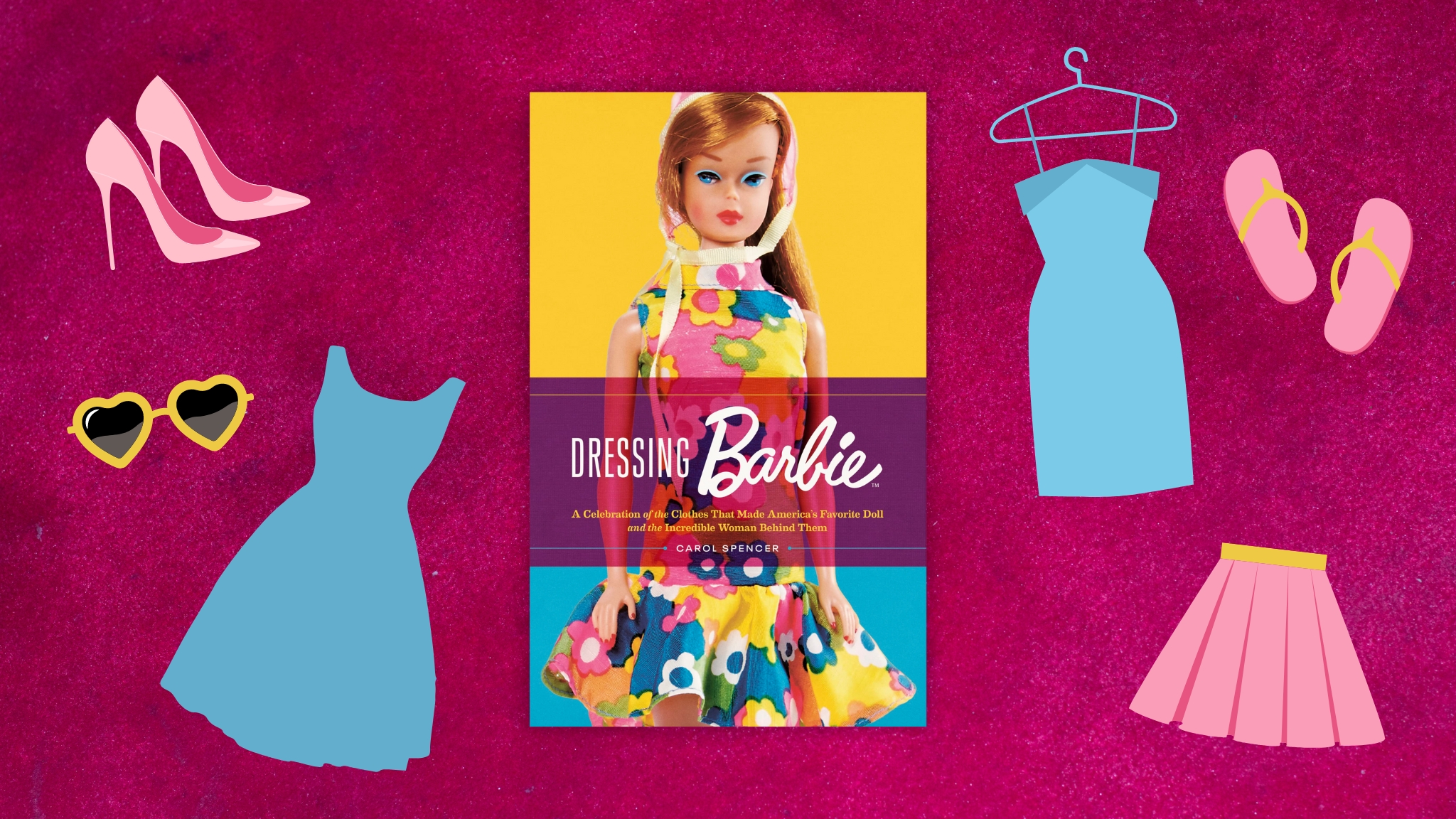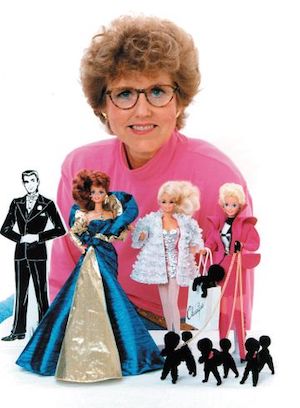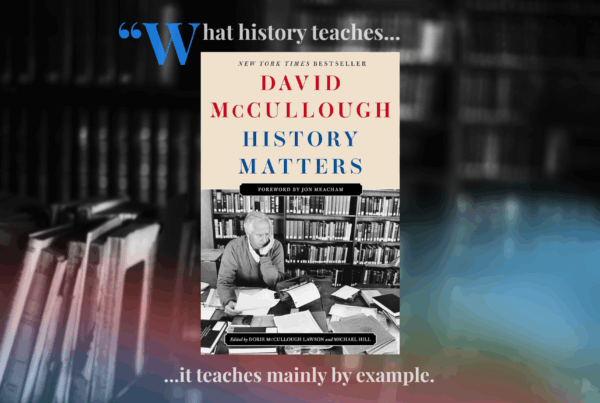Dressing Barbie by Carol Spencer
Dressing Barbie (Harper), subtitled A Celebration of the Clothes That Made America’s Favorite Doll and the Incredible Woman Behind Them written by Carol Spencer is a vibrant must-read book now available in paperback. The author has written a brief but fascinating memoir of her life and four-decade career of doll and miniature fashion design for the internationally famous, iconic 11.5” molded plastic doll named Barbie. As a Mattel insider, she also provides an informative insight into the tremendous changes in the toy industry.
With eye-popping colors, Dressing Barbie invites the reader to enter a unique museum; an individually curated Barbie and friends’ collection. It is lavishly illustrated with Carol Spencer’s own striking photographs of many of the dolls she created complete with their coordinated outfits, accessories, cars and houses along with vintage advertisements and little known information about this doll-sized world of high fashion. It’s a stunning achievement and a reference book that every Barbie fan and collector as well as anyone interested in clothing and design will want to own.
Step into this time machine and travel through the decades as the dolls and their attire changed and evolved. Artistic creator and fashion designer Carol Spencer worked closely with freelance writer, journalist and Editor Laurie Brookins to share her insights, memories and massive personal archive of dolls, documents and photographs to create this marvel. It is simply one of the best books this constant reader has read this year despite not being a doll collector or an enthusiast.
An Incredible Career All Her Own
Carol Spencer was ever an independent thinker; a girl who knew her own mind, highly intelligent, creative and massively talented. Born in 1933 in Dallas, TX, Carol was four years old and her sister Margaret a few years older when their father died and their mother moved them to Minneapolis, MN. They lived with their aunt, uncle and grandmother, a gifted seamstress and fine needle worker who passed on her talent and skills to her young granddaughter. Carol recalls that aside from the obvious roles of wife and mother, job options for women of her generation were typically limited to “nurse, teacher, secretary, shopgirl and seamstress.” Her sister willingly became a nurse. Throughout high school, Carol had dated a boy who had the expectation she would get a job and support his education and aim to become a doctor.
However, fortune smiled upon her when she attended a seminar about summer jobs in the fashion industry and heard the magic words “fashion designer.” She applied and was accepted to the Minneapolis School of Art. The boyfriend vanished after being told he needed to pay for his own education and she was then on her way to a lifelong vocation and rewarding career.
In 1955, following senior year, she was one of 20 college girls out of 37,000 applicants chosen for the ultra-prestigious Mademoiselle Magazine Guest Editor Program. This talent and achievement-based contest began in 1939 and ended forty years later in 1979; the magazine itself folded in 2001. It was the most coveted summer internship program in the field of journalism and there were only 728 Guest Editors during the forty years the program existed.
All were college students or recent graduates selected from submitted written applications, multiple essays and samples of work projects. They had to pass a rigorous series of interviews and demonstrate their talent and skill in the areas of writing, poetry, art, illustrations, photography and fashion. The winners were flown to New York City and provided housing in the strictly supervised, female-only Barbizon Hotel for their one month stay.
The chosen few would work in the editorial office of Mademoiselle on the annual oversized August college life edition. These young women received a small salary, underwent beauty makeovers, were given clothing with accessories and provided opportunities to meet and interview a dazzling array of luminaries.
Spencer was presented to the Fashion Council at a lavish cocktail party reception hosted by Helena Rubenstein in her penthouse apartment. Their itinerary was packed with activities and an introduction to a level of glamour and sophistication most of the girls had only dreamt about. For a brief moment in time, which Robin Leach, host of Lifestyles of the Rich and Famous, would have celebrated, they partook of “champagne wishes and caviar dreams.”
As Guest Editors, they interviewed famous writers, creators and celebrities, working harder than they played with the knowledge and hope they might parlay this extraordinary experience into full-time work in their chosen fields. These talented young women included many future luminary authors including Joan Didion (during Carol’s summer), Anne Beattie, Francine du Plessix Gray, Gael Greene, Sue Kaufman and Sylvia Plath who notably drew upon her experiences to write The Bell Jar. Model and actress Ali McGraw and fashion designer Betsey Johnson were among other notable alumna.
Fashion Design in Miniature
Back in Minneapolis after the magical month ended, the young Miss Spencer landed a job with the wholesale garment manufacturer Wonderalls Company as their children’s wear designer where she was responsible for an entire line of children’s clothing. After a few years there, she moved on to Junior House in Milwaukee, WI as a designer for “misses sportswear,” as the teen market was then called. In just a few years she had learned everything she could about fabrics, machinery, production patterns and overall operation of the wholesale clothing manufacturing industry and was ready for a major change when in 1962 she saw a blind ad in Women’s Wear Daily for a fashion-designer/stylist.
By early 1963, Spencer had joined the Mattel design team and Barbie became her Muse. She became part of a team of four women designers led by Charlotte Johnson, the original head fashion designer since 1959 when Barbie debuted. These mega-talented designing women came from a variety of backgrounds: Dorothy Shue began as a puppeteer in the film industry, Aileen Zublin had been a noted fashion designer in Switzerland and Kay Carter had worked as an assistant to MGM’s fabled movie wardrobe designer Adrian. They were backed by assistants who were topnotch professional seamstresses.
The windowless (to help prevent design piracy) capacious office was stocked with every imaginable type of fabric, trimmings and notions as well as art books and design reference materials. Fantasy, high style, haute couture and a dramatic flair abounded. Carol Spencer explained her specialty then was to create straightforward, practical American sportswear evoking “the meaning of true American design.”
Looking back at Carol Spencer’s life, it almost seems her destiny was to become the chief fashion designer and premiere influential creative designer at Mattel. She was present during the evolution of the small family held firm to its expansion into a multinational corporate giant during her nearly 36 years with the company. She was inducted into the National Toy Hall of Fame in February, 2017. During her career at Mattel, she kept abreast of trendsetting designs traveling the world to attend major couturier fashion shows in Paris, London, Milan and stateside in New York. Carol participated in international toy design fairs and also kept up-to-date by reading leading fashion magazines.
Innovation Under Pressure
The 1980s were a time of global business travel for Spencer. She had already been a top designer for over two decades and earned her MBA while working full time. Carol made several trips to Hong Kong to oversee a new line before being chosen for a two year assignment heading up a new Hong Kong based design department in 1988. Prior to this, she had proven her executive negotiating abilities while based in Tokyo for six weeks working with MA-BA (Mattel and Bandai Toys) on Japan’s Barbie dolls. During her stint in Hong Kong, she continued to design clothing lines.
Presented with a daunting challenge while there, a computer malfunction had resulted in surplus fabric and materials in several factories. Back in 1968 at Mattel Toyland headquarters, a similar problem had occurred when 2500 instead of 250 yards of luxurious white fabric striped with gold metallic threads had been accidentally ordered. Some was used to make a swimsuit with matching headscarf but the bulk of the material languished in the warehouse.
The quick thinking innovator came up with two elegant outfits for evening wear; a cocktail dress called “The Country Club Dance” and a long gown “Holiday Dance” that utilized all the remains and which became a future sought after collectible. Fast forward twenty years to Hong Kong where excess inventory fully filled three warehouses overflowing to two 40’ containers dockside.
Spencer’s ingenious solution was to create a large series of designs for inexpensive outfits in simple packaging suitable for check-out counter impulse buys thus expending the entire stock before she returned to Southern California. During the next decade she was honored as the first Barbie fashion designer to have her signature on the doll as well as on packaging. She is credited for the creation of the best-selling Totally Hair Barbie. Recognizing the potential for a collector’s market, Carol designed the first limited-edition Barbie spawning many others including the Hollywood Legends line.
Carol went on signing tours and continues to meet with Mattel Collector’s Clubs. Her fashion designs can be found in many museums, including the Smithsonian Institution. Her opulent one-of-a-kind Empress Sissy Barbie raised over $50,000 in an auction to benefit Vienna’s Schönbrunn Palace.
Ruth Handler and her husband Elliot co-founded Mattel Toys in 1945. There are two origin stories about the development of the first Barbie doll. The first is that the Handlers visited an international toy trade show in Germany and were inspired by a German fashion doll named “Bild Lilli” or “Picture Lilly”, manufactured from 1952-1964. Returning home Ruth observed their daughter Barbara playing animatedly with her paper dolls leading her to create a teen-age doll named after her. Most American made dolls were baby dolls or toddlers like “Betsy Wetsy” or “Nancy Walker” dolls.
The original Barbie was introduced in March 1959 and sold over 351,000 dolls that year. “Ponytail Barbie” was an 18-year-old fashion model, either blonde or brunette who wore a black and white striped one-piece swimsuit, black open-toe heels, hoop earrings and sunglasses. Retail price was $3. The revolution in toys had begun. Girls of all ages fell in love with Barbie. The doll is sold in over 150 countries. A mint condition in the box first year Barbie sold for over $27,000 in recent years and even well-loved ones may fetch $3-8,000.
Trailblazing to This Day
Carol Spencer, along with the early and subsequent designers, have fired the imagination and inspired career ambitions for countless children worldwide. Barbie was and continues to be a ground-breaker demonstrating that women can succeed in professions formerly limited to men. For example, the first astronaut outfits debuted in 1964, 14 years before the initial six women astronauts were chosen by NASA.
Over the years, Barbie has portrayed over 200 careers encompassing the fields of medicine, athletics, military, politics, education, arts, media and business among others with greater emphasis on STEM professions in recent years. Although, she acquired a changing array of sisters, since 1961 Ken has been her boyfriend, although they have never married. He was named for the Handler’s son Kenneth. Barbie is an independent, self-reliant confident woman who has served as a shining example of self-made success for generations of girls. That is an accomplishment to be lauded.
Dressing Barbie is a celebration of America’s favorite doll and an excellent remembrance of Spencer’s life as one of America’s finest fashion and doll designers. Her dedication sums it up: “I dedicate this book to the child in all of us as we play, dream and evolve. Enjoy!” May we always be able to retain youthful enthusiasm and imagination!


 Carol Spencer worked for several years as a fashion designer and illustrator in the apparel industry before beginning her illustrious career at Mattel as a fashion designer for Barbie in 1963. For thirty-five years, Carol created thousands of designs for the iconic doll and watched as Mattel grew from a small business into a multi-national conglomerate. From seeing Paris fashion shows to running the Hong Kong design group in the 1980s, Carol has been around the world with Barbie. Since retiring in 1998, she has continued to reside in Los Angeles with her impressive personal collection of Barbie dolls.
Carol Spencer worked for several years as a fashion designer and illustrator in the apparel industry before beginning her illustrious career at Mattel as a fashion designer for Barbie in 1963. For thirty-five years, Carol created thousands of designs for the iconic doll and watched as Mattel grew from a small business into a multi-national conglomerate. From seeing Paris fashion shows to running the Hong Kong design group in the 1980s, Carol has been around the world with Barbie. Since retiring in 1998, she has continued to reside in Los Angeles with her impressive personal collection of Barbie dolls.


